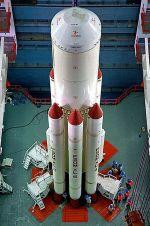 | « Back to article | Print this article |
 India's heaviest rocket ever is expected to take to the sky next January on an experimental flight whose later versions could be used to send humans on space missions.
India's heaviest rocket ever is expected to take to the sky next January on an experimental flight whose later versions could be used to send humans on space missions.
The mainstay of the Geosynchronous Satellite Launch Vehicle-Mark III (GSLV-Mk III) would be to put in orbit communication satellites weighing between four and five tonnes, thus packing more transponders per launch.
"We are targeting an experimental flight of GSLV-Mk III in January 2014," Indian Space Research Organisation Chairman K Radhakrishnan told reporters after a public lecture at the IndianNationalScienceAcademy.
This will also be a first time that ISRO scientists would undertake an experimental flight of a launch vehicle which would fall into the sea after reaching a height of 120 km.
"We have been simulating the flight using computers. But there are certain tests that cannot be carried out on the ground. We will test the rocket in a cost effective manner," GSLV-Mk III's project director S Somnath said.
He said ISRO engineers have planned to take some 2,000 measurements during the experimental flight of the GSLV-Mk III, which would weigh 640 tonnes at lift-off, making it the heaviest rocket built in the country.
"All the 2000 measurements during the flight would be telemetered down to the ground station. We will analyse them. This will enable us to have full knowledge of the flight," Somnath said.
The new rocket, which can put a four tonne satellite in orbit, will help Antrix Corporation, ISRO's commercial arm, to offer cheapest space launches in the niche market.
The GSLV Mark III will enable ISRO launch heavier satellites, an activity for which it has to turn to foreign launch vehicles like Arianspace, based in Kourou in French Guiana.
GSLV Mark III is designed to be a three-stage 42.4 m tall vehicle with two strap-on booster rockets of 200 tonnes each using a solid propellant. The massive rockets, each with a diameter of 3.2 mt and 25 mt in length, would be strapped on to the L110 re-startable liquid stage.
For the experimental flight, the third stage would be a passive cryogenic upper stage loaded with 27 tonnes of liquid nitrogen.
The cryogenic stage for the GSLV-MkIII are gas generator based engines developed at the Aerospace Wing of Godrej.
ISRO's existing rockets -- the three stage GSLV and four stage Polar Satellite Launch Vehicle -- has a lower carrying capacity.
The present GSLV can carry a payloads of up to 2.5 tonne to the geo-transfer orbit while PSLV can launch 1.6 tonne and 1.1 tonne satellites into polar orbit and GTO respectively.
After two successive failures in 2010, ISRO has also planned a July launch for the current GSLV to put in orbit a communication satellite GSAT 14. The GSLV would use an indigenously developed cryogenic engine.
The stacking of the GSLV had started at Sriharikota on January 31 and the first stage of the rocket has been integrated. ISRO engineers will carry out a mission readiness review on Wednesday which would be followed by integration of the second stage.
The cryogenic upper stage has been almost integrated at an ISRO centre in Mahendragiri and would be brought to Sriharikota early May.